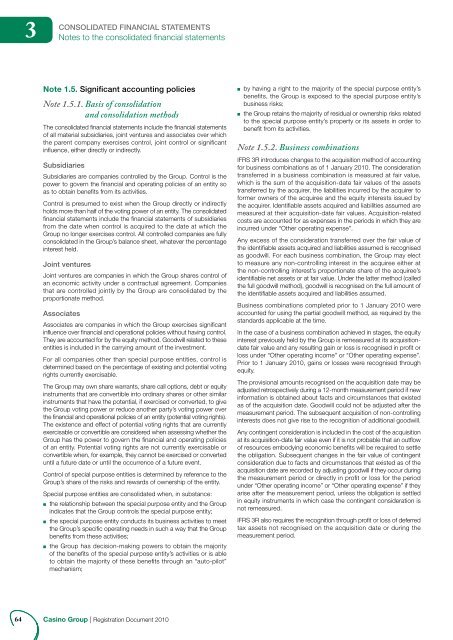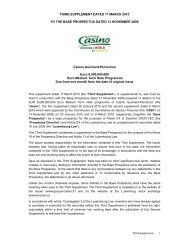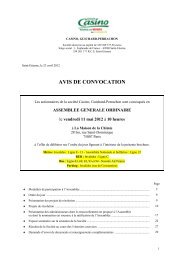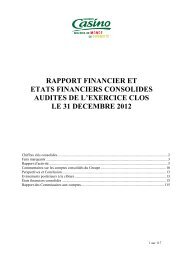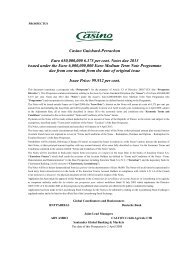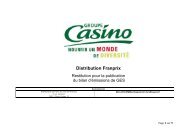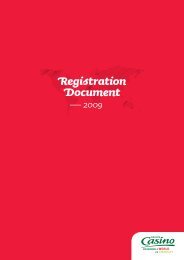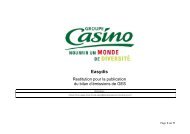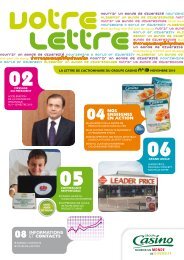2010 REGISTRATION DOCUMENT (3.4 Mo) - Groupe Casino
2010 REGISTRATION DOCUMENT (3.4 Mo) - Groupe Casino
2010 REGISTRATION DOCUMENT (3.4 Mo) - Groupe Casino
You also want an ePaper? Increase the reach of your titles
YUMPU automatically turns print PDFs into web optimized ePapers that Google loves.
3CONSOLIDATED FINANCIAL STATEMENTSNotes to the consolidated fi nancial statementsNote 1.5. Significant accounting policiesNote 1.5.1. Basis of consolidationand consolidation methodsThe consolidated financial statements include the financial statementsof all material subsidiaries, joint ventures and associates over whichthe parent company exercises control, joint control or significantinfluence, either directly or indirectly.SubsidiariesSubsidiaries are companies controlled by the Group. Control is thepower to govern the financial and operating policies of an entity soas to obtain benefits from its activities.Control is presumed to exist when the Group directly or indirectlyholds more than half of the voting power of an entity. The consolidatedfinancial statements include the financial statements of subsidiariesfrom the date when control is acquired to the date at which theGroup no longer exercises control. All controlled companies are fullyconsolidated in the Group’s balance sheet, whatever the percentageinterest held.Joint venturesJoint ventures are companies in which the Group shares control ofan economic activity under a contractual agreement. Companiesthat are controlled jointly by the Group are consolidated by theproportionate method.AssociatesAssociates are companies in which the Group exercises significantinfluence over financial and operational policies without having control.They are accounted for by the equity method. Goodwill related to theseentities is included in the carrying amount of the investment.For all companies other than special purpose entities, control isdetermined based on the percentage of existing and potential votingrights currently exercisable.The Group may own share warrants, share call options, debt or equityinstruments that are convertible into ordinary shares or other similarinstruments that have the potential, if exercised or converted, to givethe Group voting power or reduce another party’s voting power overthe financial and operational policies of an entity (potential voting rights).The existence and effect of potential voting rights that are currentlyexercisable or convertible are considered when assessing whether theGroup has the power to govern the financial and operating policiesof an entity. Potential voting rights are not currently exercisable orconvertible when, for example, they cannot be exercised or converteduntil a future date or until the occurrence of a future event.Control of special purpose entities is determined by reference to theGroup’s share of the risks and rewards of ownership of the entity.Special purpose entities are consolidated when, in substance:■■■the relationship between the special purpose entity and the Groupindicates that the Group controls the special purpose entity;the special purpose entity conducts its business activities to meetthe Group’s specific operating needs in such a way that the Groupbenefits from these activities;the Group has decision-making powers to obtain the majorityof the benefits of the special purpose entity’s activities or is ableto obtain the majority of these benefits through an “auto-pilot”mechanism;■■by having a right to the majority of the special purpose entity’sbenefits, the Group is exposed to the special purpose entity’sbusiness risks;the Group retains the majority of residual or ownership risks relatedto the special purpose entity’s property or its assets in order tobenefit from its activities.Note 1.5.2. Business combinationsIFRS 3R introduces changes to the acquisition method of accountingfor business combinations as of 1 January <strong>2010</strong>. The considerationtransferred in a business combination is measured at fair value,which is the sum of the acquisition-date fair values of the assetstransferred by the acquirer, the liabilities incurred by the acquirer toformer owners of the acquiree and the equity interests issued bythe acquirer. Identifiable assets acquired and liabilities assumed aremeasured at their acquisition-date fair values. Acquisition-relatedcosts are accounted for as expenses in the periods in which they areincurred under “Other operating expense”.Any excess of the consideration transferred over the fair value ofthe identifiable assets acquired and liabilities assumed is recognisedas goodwill. For each business combination, the Group may electto measure any non-controlling interest in the acquiree either atthe non-controlling interest’s proportionate share of the acquiree’sidentifiable net assets or at fair value. Under the latter method (calledthe full goodwill method), goodwill is recognised on the full amount ofthe identifiable assets acquired and liabilities assumed.Business combinations completed prior to 1 January <strong>2010</strong> wereaccounted for using the partial goodwill method, as required by thestandards applicable at the time.In the case of a business combination achieved in stages, the equityinterest previously held by the Group is remeasured at its acquisitiondatefair value and any resulting gain or loss is recognised in profit orloss under “Other operating income” or “Other operating expense”.Prior to 1 January <strong>2010</strong>, gains or losses were recognised throughequity.The provisional amounts recognised on the acquisition date may beadjusted retrospectively during a 12-month measurement period if newinformation is obtained about facts and circumstances that existedas of the acquisition date. Goodwill could not be adjusted after themeasurement period. The subsequent acquisition of non-controllinginterests does not give rise to the recognition of additional goodwill.Any contingent consideration is included in the cost of the acquisitionat its acquisition-date fair value even if it is not probable that an outflowof resources embodying economic benefits will be required to settlethe obligation. Subsequent changes in the fair value of contingentconsideration due to facts and circumstances that existed as of theacquisition date are recorded by adjusting goodwill if they occur duringthe measurement period or directly in profit or loss for the periodunder “Other operating income” or “Other operating expense” if theyarise after the measurement period, unless the obligation is settledin equity instruments in which case the contingent consideration isnot remeasured.IFRS 3R also requires the recognition through profit or loss of deferredtax assets not recognised on the acquisition date or during themeasurement period.64 <strong>Casino</strong> Group | Registration Document <strong>2010</strong>


